One of them is the fiscal goal for the first quarter set at $960,000 million. To reach them, it already obtained $2 billion in January from a phenomenal spending adjustment, the most important in the last 30 years. The other is from Central Bank reserves.
“The surplus was finally greater than expected explained by the absence of State management, the freezing of expenditure items, and the liquefaction of items linked to social benefits”, says economist Hernán Letcher, director of the Center for Argentine Political Economy (CEPA).
strain-metas-fmi.png
The analyst maintains that “the fiscal goal with the IMF was modified and It was established at a surplus of $960,000 million for the month of March; with the surplus of $2,010 billion in January the fiscal goal, for now, “it looks doable”says Letcher.
Economists maintain that The large result achieved in the first month of the year cannot be sustained with the same proportion in the following months, because it was achieved based on the liquefaction of salaries and retirements and the non-payment of commitments. Of the 2 billion primary surplus in January, 45% was contributed by the delay in retirements.
Luis Caputo will hardly be able to stay sitting on the box in the coming weeks, although in his head he knows that during the first half of the year he has to achieve the largest possible surplus to compensate for the increase in expenses that characterizes the second semesterwhen the income from withholdings resulting from the liquidation of the harvest also decreases.
So probably in February and In March the fiscal result tends to reduce the level of surplus or even, with a small deficit, which will be offset by the January result.
Is January’s spending adjustment sustainable?
The stock company Romano Group maintains in this regard that “although this is the first complete monthly exercise of this management, we should not fall into the illusion that just blending is enough, since to do so it is necessary to inevitably coexist with higher inflation.” “Liquefying is not sanitizing, and to guarantee growth for the medium and long term, Argentina needs the latter,” Romano Group warns.
The BCRA has already achieved the reserves planned for March
The other objective that the Government can show as practically achieved for the first quarter before the IMF is the goal of accumulation of international reserves. For On March 31, the Central Bank must have added about US$6,000 million, counted from the moment the new management took over.
As of Tuesday, January 20, the Central Bank reported gross international reserves of US$27,092 million, which implies that the entity that directs Santiago Bausili managed to accumulate up to that point US$6,075 since December 11.
In February the government already paid US$781 million in maturities to the BCRA, and has maturities of US$217 million with multilateral organizations. In March the entity has to pay US$824 million, which correspond to US$749 million with multilaterals, US$63 in BCRA bills and US$12 million in public securities. In the market, it is expected that the BCRA will meet the objective if the daily dollar purchase rate is maintained.
Source: Ambito




